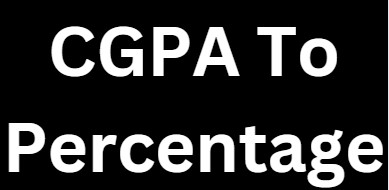The conversion of CGPA (Cumulative Grade Point Average) to percentage is a common need for students and professionals who want to represent their academic performance in a more universally accepted format. This guide provides a clear and detailed approach to converting CGPA to percentage, including different methods, practical examples, and essential considerations.
What is CGPA?
CGPA stands for Cumulative Grade Point Average and reflects a student’s overall academic performance. It is calculated by averaging the grade points earned across various courses or semesters. CGPA scales can differ:
- 10-Point Scale: CGPA ranges from 0 to 10.
- 4.0 Scale: CGPA ranges from 0 to 4.0.
Understanding the scale of CGPA used by your institution is crucial for accurate conversion.
Why Convert CGPA to Percentage?
- Application Requirements: Many job applications and educational programs require academic performance to be reported as a percentage.
- Standardized Comparison: Percentages offer a standard way to compare academic achievements across different institutions and grading systems.
- Official Documentation: Certain official documents and certifications may require percentage-based academic records.
Conversion Methods
Several methods are used to convert CGPA to percentage, depending on the grading scale of your institution:
- 10-Point Scale Conversion:
- Formula: Percentage=CGPA×9.5\text{Percentage} = \text{CGPA} \times 9.5Percentage=CGPA×9.5
- Explanation: This formula is often used for institutions with a 10-point CGPA scale. For example, if your CGPA is 6.9: Percentage=6.9×9.5=65.55%\text{Percentage} = 6.9 \times 9.5 = 65.55\%Percentage=6.9×9.5=65.55%
- 4.0 Scale Conversion:
- Formula: Percentage=CGPA×25\text{Percentage} = \text{CGPA} \times 25Percentage=CGPA×25
- Explanation: This method is typically used for institutions with a 4.0 CGPA scale. For example, if your CGPA is 3.7: Percentage=3.7×25=92.5%\text{Percentage} = 3.7 \times 25 = 92.5\%Percentage=3.7×25=92.5%
- Institution-Specific Formulas:
- Explanation: Some institutions may have unique conversion formulas. Check your institution’s guidelines to ensure you use the correct method.
MAIN SITE
Practical Conversion Examples
To illustrate the conversion process, let’s consider two examples:
- Example for 10-Point Scale:
- CGPA: 7.6
- Conversion: Percentage=7.6×9.5=72.2%\text{Percentage} = 7.6 \times 9.5 = 72.2\%Percentage=7.6×9.5=72.2%
- Example for 4.0 Scale:
- CGPA: 3.0
- Conversion: Percentage=3.0×25=75%\text{Percentage} = 3.0 \times 25 = 75\%Percentage=3.0×25=75%
Key Considerations
- Institutional Guidelines: Always confirm the conversion method with your educational institution, as different institutions might use different scales or formulas.
- Grading Scale Understanding: Be sure you know whether your CGPA is on a 10-point scale, 4-point scale, or another system before applying the conversion formula.
Conclusion
Converting CGPA to percentage is an important step for presenting your academic performance in a widely accepted format. By understanding and applying the correct conversion methods based on your institution’s grading system, you can accurately translate your CGPA into a percentage. This conversion is useful for job applications, further education, and other scenarios where a percentage-based representation of academic achievement is required.















